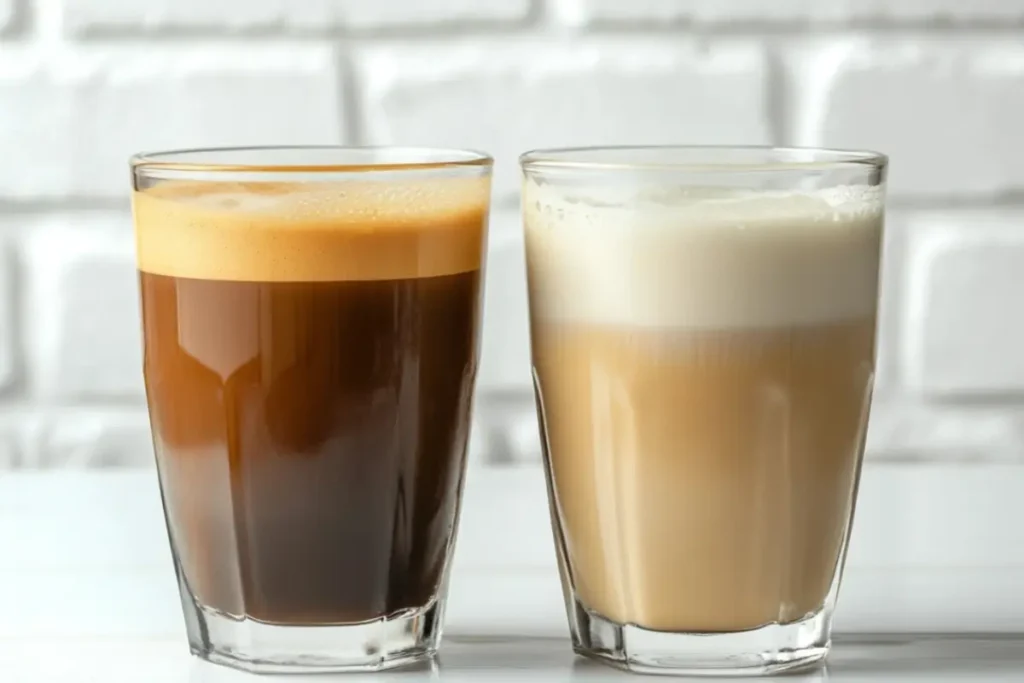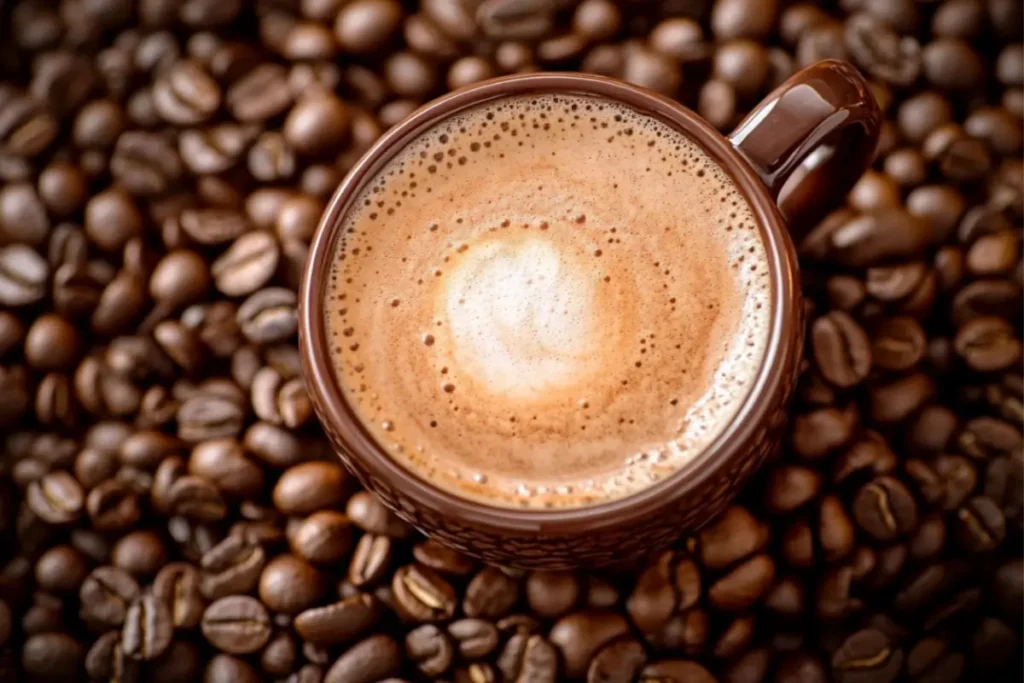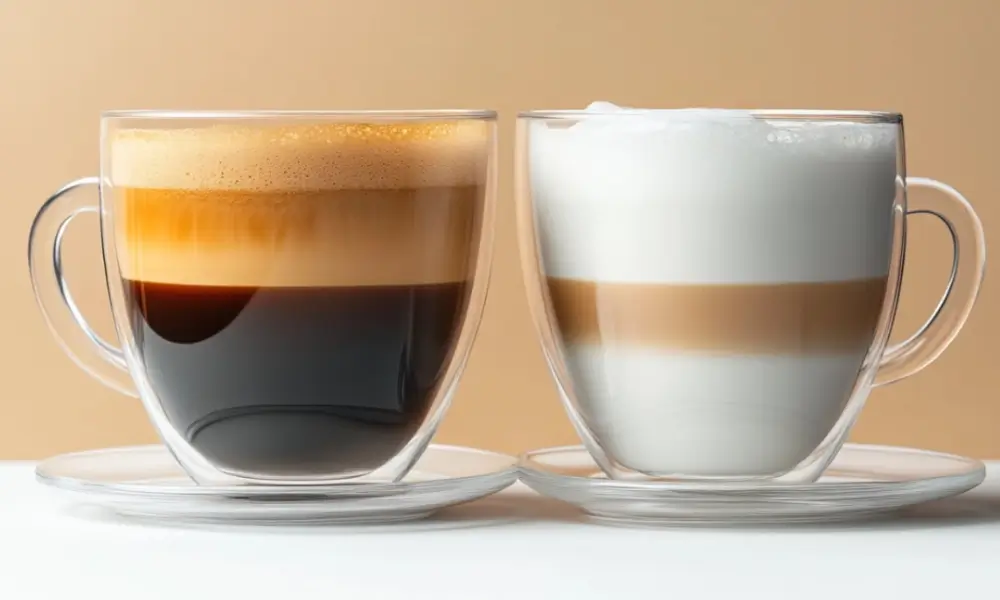Ever found yourself staring at a coffee menu, completely stumped by all the choices? You’re not alone! Among those intriguing names, two options often spark curiosity: the breve and the latte. But what’s the deal with these drinks? More importantly, is a breve healthier than a latte? Let’s dive into the delicious details and find out.
Understanding Breve and Latte: Key Differences
What is a Breve?
A breve is like the fancy cousin of a latte. Instead of regular milk, it’s made with half-and-half—yes, that creamy combo of milk and heavy cream. Picture this: a velvety, rich cup of coffee that feels more like dessert. Sounds indulgent, right? Well, it is. That’s what makes the breve a go-to for anyone craving something ultra-decadent. It’s not your everyday coffee but more of a treat-yourself moment in a cup. Think of it as the espresso world’s version of a luxurious dessert—like cheesecake, but for coffee lovers!
Breve is actually the Italian word for “short,” but there’s nothing short about its flavor. The addition of half-and-half gives it a luxurious creaminess that coats your tongue, creating a silky experience sip after sip. If you’re the type to savor every moment, a breve might just be your cup of (coffee) joy.
What is a Latte?
On the other hand, a latte is like your friendly neighborhood drink. It’s a mix of espresso and steamed milk, topped with a little froth for good measure. Lattes are versatile—you can add flavors, switch up the milk, and even go non-dairy. No wonder they’re a coffee shop staple! If a breve is the indulgent treat, a latte is the dependable go-to. It’s a perfect balance of creamy and comforting without tipping over into “too much” territory.
Lattes have a long history of being customizable. From seasonal pumpkin spice to classic vanilla, they’re like a blank canvas for coffee lovers. Whether you’re rushing through a busy morning or relaxing on a weekend, a latte can adapt to your mood. That’s why it’s so popular!
How Are Breves and Lattes Made?
The process for both drinks starts the same: a shot (or two) of espresso. From there, it’s all about the milk choice. A breve gets steamed half-and-half, while a latte opts for steamed milk. The result? Two entirely different taste experiences. If a breve is like rich cheesecake, a latte is like a smooth yogurt parfait. They may share the same base, but their final flavors couldn’t be more different.
For a breve, the half-and-half is lightly steamed to maintain its creamy texture. This process adds to its velvety richness, creating a drink that’s undeniably indulgent. A latte, on the other hand, focuses on a balanced blend of flavors. The steamed milk blends seamlessly with the espresso, creating a mellow, smooth taste with just a touch of froth on top.
Nutritional Comparison: Breve vs. Latte

Calories in a Breve vs. Latte
Let’s talk numbers. A typical 12-ounce breve packs about 425 calories, while a latte of the same size comes in at around 190 calories. That’s a huge difference! Why? It all boils down to the heavy cream in the breve. Half-and-half is significantly richer than milk, which is why breves are so calorie-dense. So, if you’re counting calories, the latte might be the lighter pick.
Think of it this way: drinking a breve is like enjoying a slice of rich, creamy cake, while a latte is more like a small bowl of oatmeal. Both are satisfying in their own way, but one is definitely more indulgent than the other. For anyone on a calorie-conscious journey, this is something to keep in mind.
Fat Content Analysis
Fat is another area where the breve and latte don’t see eye to eye. Thanks to its half-and-half base, a breve has roughly 40 grams of fat. A latte? Only about 7 grams. That’s nearly six times the amount of fat! Now, fat isn’t all bad—it keeps you full and adds flavor—but too much can weigh you down, literally.
The type of fat also matters. Breves are high in saturated fat, which is the kind that can raise cholesterol levels when consumed in excess. Meanwhile, the fat in milk (used in lattes) is more balanced, offering a mix of saturated and unsaturated fats. This is one reason why lattes are often seen as the healthier choice.
Protein and Carbohydrate Content
Surprisingly, both drinks have about the same protein—around 7–8 grams. Protein is essential for muscle repair and keeping you feeling full, so this is a win for both drinks. But when it comes to carbs, lattes take the lead with about 18 grams, while breves stay at a lower 10 grams. That’s because heavy cream has fewer carbs than milk. Who knew?
If you’re someone who needs a little extra energy, the higher carb count in a latte could be a good thing. Carbs are your body’s quick source of energy, so they can be helpful during a busy morning or an afternoon slump.
Health Benefits of Breve and Latte

Advantages of Drinking a Breve
Breves aren’t just about indulgence; they do have perks. The high-fat content can provide a quick energy boost, especially if you’re following a keto diet. The creamy, rich texture also makes it feel like a treat, which can be a nice little pick-me-up on a tough day. Sometimes, comfort foods (or drinks) are just what you need.
“Sometimes, a breve is more than a drink—it’s comfort in a cup.” ☕
For those looking to cut carbs, breves can be a surprisingly good option. Since heavy cream is low in carbohydrates, it fits well into low-carb and ketogenic diets. It’s a way to indulge without derailing your dietary goals.
Benefits of Opting for a Latte
Lattes, on the other hand, are like the overachievers of the coffee world. They’re versatile, lower in calories, and easy to customize. Add some oat milk for extra fiber or a splash of vanilla for sweetness without adding sugar. Whether you’re on the go or sitting down for brunch, a latte fits right in.
Lattes are also a great option if you’re looking for a balanced drink. The combination of milk and espresso provides a good mix of protein, carbs, and a touch of fat. Plus, if you’re someone who enjoys experimenting, the latte’s versatility means you can keep it exciting without overloading on calories or sugar.
Common Concerns: Is Breve Really Healthier?
The Role of Heavy Cream in Breve
Heavy cream is the heart of a breve, but it’s also what makes people hesitate. It’s high in saturated fat, which can raise cholesterol levels if consumed in excess. So while it’s delicious, it might not be the healthiest choice if you’re sipping on breves every day.
Is Dairy Milk in a Latte a Better Choice?
Dairy milk in a latte offers a balanced mix of protein, carbs, and fat. Plus, it’s packed with calcium and vitamin D, making it a nutrient-rich option. For those aiming for a middle ground between indulgence and nutrition, the latte edges out the breve as the healthier option. But hey, moderation is key!
Customizing Your Drink for Healthier Options
Healthier Breve Variations
Love breves but want a lighter twist? Try swapping out half-and-half for low-fat cream or even almond milk. It won’t be quite as creamy, but it’ll save you some calories and fat.
Making a Latte with Non-Dairy Milk
Non-dairy options like almond, oat, or soy milk can transform your latte into a plant-based powerhouse. These milks are often lower in calories and fat but still add a smooth, rich texture. Plus, they’re great for anyone avoiding dairy!
| Ingredient | Breve | Latte |
|---|---|---|
| Calories | 425 | 190 |
| Fat | 40g | 7g |
| Protein | 8g | 7g |
| Carbs | 10g | 18g |
So, which drink wins the health contest? Stay tuned for the second part where we’ll dive deeper into tips, common myths, and expert advice to help you choose the best option for your lifestyle!
Who Should Avoid Breve or Latte?

Dietary Restrictions and Allergies
Before indulging in a breve or latte, it’s essential to consider any dietary restrictions. Breves, made with half-and-half, are not suitable for individuals with lactose intolerance or dairy allergies. Even lattes, which traditionally use milk, can cause issues for those sensitive to dairy. Luckily, there are plenty of alternatives, like almond, oat, or soy milk, that can cater to your needs.
For anyone following a low-fat or low-calorie diet, breves might be a less favorable choice. The heavy cream in breves contributes significantly to their high fat and calorie content, which could derail health goals if consumed regularly. Lattes, on the other hand, are more adaptable, offering lower-fat options and fewer calories while still providing a satisfying coffee experience.
Health Conditions Impacted by High-Fat Drinks
If you have conditions like high cholesterol or heart disease, the saturated fat in breves could be a concern. Heavy cream, the star ingredient in breves, is high in saturated fat, which can increase LDL cholesterol levels and potentially harm heart health. On the flip side, lattes made with low-fat or plant-based milk can be a heart-healthier option while still delivering that delicious espresso flavor.
However, that doesn’t mean you have to avoid breves entirely. Moderation is the key! Treating yourself to a breve occasionally won’t ruin your health—it’s all about balance. Think of it like having dessert after dinner—it’s fine as long as it’s not an everyday habit.
Tips for Making Healthier Coffee Choices
Choosing the Right Ingredients
The foundation of a healthy coffee lies in the ingredients. For breves, swapping half-and-half for low-fat cream or even a mix of cream and almond milk can significantly reduce calories and fat. For lattes, using non-dairy milk like oat or almond not only lowers calorie content but can also add a unique flavor twist.
If you’re making coffee at home, pay attention to sweeteners. Artificial syrups can quickly turn your drink into a sugar bomb. Opt for natural options like honey, maple syrup, or a dash of cinnamon for sweetness without the sugar overload.
Controlling Portion Sizes
It’s easy to go overboard with coffee portions, especially when indulging in a creamy breve. Stick to smaller sizes like an 8-ounce cup to enjoy the flavor without overdoing it. Remember, coffee drinks can sneak in extra calories if you’re not careful with portion sizes, especially when adding toppings like whipped cream or chocolate drizzle.
“Sometimes, less is more—especially when it comes to coffee. A smaller cup can still pack big flavor!” ☕
Common Myths About Breve and Latte Debunked
“Breves Are Always Unhealthy”
While breves do have more calories and fat, labeling them as “unhealthy” isn’t entirely fair. They can be part of a balanced diet if consumed occasionally. Plus, for those on a ketogenic or low-carb diet, breves fit the bill thanks to their low carbohydrate content. It all comes down to how you incorporate them into your lifestyle.
“Lattes Are Just Flavored Milk”
This myth couldn’t be further from the truth. Lattes are a harmonious blend of espresso and steamed milk, offering a balance of nutrients. The milk provides protein, calcium, and vitamins, while the espresso delivers an energy boost. Customization options also mean you can tailor a latte to fit your dietary needs or flavor preferences.
Expert Opinions on Breve vs. Latte
Nutritionists’ Take on Breve
Many nutritionists agree that breves can be enjoyed as an occasional treat, especially for those who love their rich, creamy texture. However, they caution against making them a daily habit due to their high saturated fat and calorie content. A healthier twist? Use a mix of half-and-half and milk to reduce the richness without sacrificing flavor.
Baristas’ Perspective on Customizing Orders
Baristas know that coffee preferences are personal, and they’re always happy to help you create a drink that suits your taste and health goals. Want a lighter breve? Ask for a splash of cream instead of full-on half-and-half. Prefer a dairy-free latte? Most coffee shops offer plenty of non-dairy milk options, like almond or oat, to keep your order both tasty and health-conscious.
Frequently Asked Questions
Is breve keto-friendly?
Yes, breve is keto-friendly! Thanks to its low carbohydrate content, it fits perfectly into a ketogenic diet. The heavy cream in half-and-half provides fat without adding carbs, making it a favorite among keto enthusiasts. However, keep an eye on portion sizes to avoid consuming too many calories.
Can I make a healthier breve at home?
Absolutely! Making a healthier breve at home is easier than you might think. Swap out traditional half-and-half for a mix of light cream and unsweetened almond milk to cut back on calories and fat. You can also use sugar-free syrups or natural sweeteners like stevia for added flavor without the extra sugar.
What is the best milk option for lattes?
The best milk option for lattes depends on your dietary preferences and taste. Regular dairy milk offers a creamy texture and balanced nutrients, while non-dairy options like oat milk add a slightly nutty flavor. If you’re watching calories, almond or skim milk can be excellent choices. Experiment to find your favorite!
Curious About Breve?
Want to learn more? Check out breve coffee for its creamy charm, what is a breve coffee for a quick overview, or even how to pronounce breve coffee to say it like a pro!
Final Thoughts: Which Is Better for Your Health?
So, is a breve healthier than a latte? The answer depends on your goals. If you’re looking for a low-carb option or a rich treat, a breve can be a fantastic choice—just keep it occasional. On the other hand, if you want something more balanced and customizable, a latte might be your best bet. Either way, enjoy your coffee journey, and don’t be afraid to experiment to find what suits your lifestyle best!


